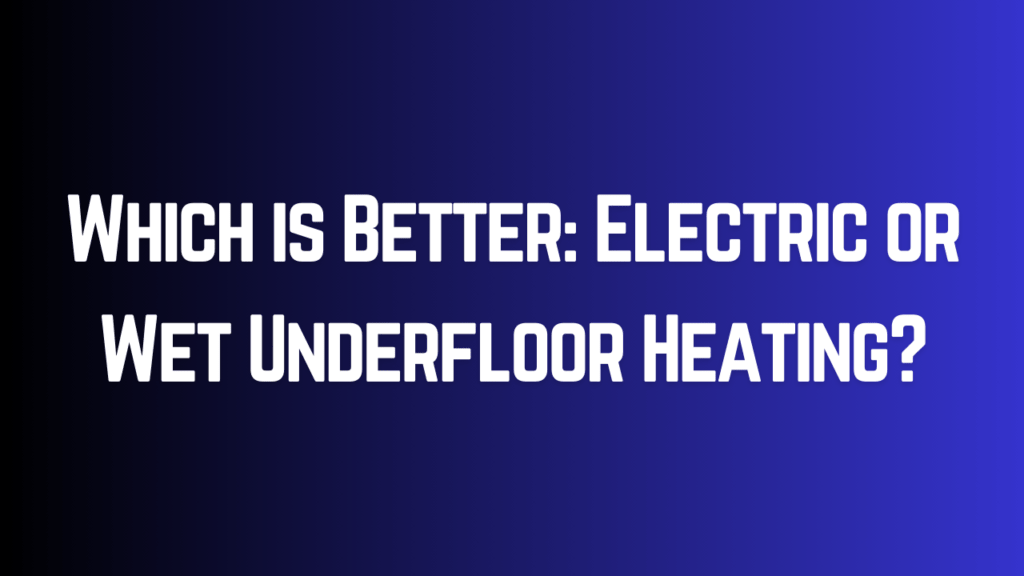
Underfloor heating has become an increasingly popular choice when it comes to heating your home efficiently and effectively. It offers a level of comfort and warmth that traditional radiators can’t match. However, if you’re considering underfloor heating, you may face a crucial decision: electric or wet underfloor heating. In this comprehensive guide, we will delve into the details of both options to help you make an informed choice.
Consider your needs, budget, and space size when choosing between electric and wet underfloor heating. Electric is simpler for smaller areas, while wet heating is more efficient in larger spaces and can integrate with your central heating system.
Electric Underfloor Heating: The Modern Marvel
Electric underfloor heating has gained recognition for its simplicity and efficiency. Here’s what you need to know:
1. Installation and Cost
Electric underfloor heating systems are known for their ease of installation. They consist of heating mats or cables placed directly beneath your flooring. This setup eliminates the need for complex plumbing work, making it a cost-effective option for new builds and renovations.
2. Energy Efficiency
One of the primary advantages of electric underfloor heating is its energy efficiency. These systems heat up quickly and can be controlled room by room, allowing you to optimize energy usage. Moreover, they are compatible with renewable energy sources, such as solar panels, further reducing your carbon footprint.
3. Maintenance
Electric underfloor heating systems are virtually maintenance-free. Once installed, they require minimal attention, saving you time and money in the long run.
4. Warm-Up Time
Electric underfloor heating excels in this department if you’re looking for rapid warmth. It can reach your desired temperature within minutes, ensuring your space feels cozy in no time.
5. Floor Height
One consideration with electric underfloor heating is the slight increase in floor height due to the heating elements. While this may not be a concern for most, it’s worth noting if you have limited space.
Wet Underfloor Heating: The Hydronic Alternative
Wet underfloor heating, or hydronic heating, is another popular choice. Here’s a closer look at its features:
1. Installation and Cost
Wet underfloor heating systems involve a more intricate installation process. They require pipes to be laid beneath the floor, through which hot water is circulated. While the installation may be more complex and expensive upfront, it can be more cost-effective in the long term.
2. Energy Efficiency
Hydronic heating is highly efficient when it comes to maintaining a consistent temperature. The heated water retains heat well, ensuring your space remains warm even after the system is turned off. This efficiency can result in lower energy bills over time.
3. Maintenance
Similar to electric systems, wet underfloor heating requires minimal maintenance once installed. The pipes are durable and typically have a long lifespan.
4. Warm-Up Time
Compared to electric underfloor heating, wet systems may take a bit longer to reach your desired temperature. However, this delay is usually insignificant and is compensated for by the system’s overall efficiency.
5. Floor Height
Wet underfloor heating doesn’t add any extra height to your floor, as the pipes are installed within the subfloor. This can be advantageous if preserving the existing floor height is crucial in your design.
Choosing the Right Option for You
So, which is better: electric or wet underfloor heating? The answer depends on your specific needs and priorities.
Choose Electric Underfloor Heating If:
You want a straightforward and cost-effective installation.
Energy efficiency and control over individual rooms are essential to you.
Quick warm-up times are a priority.
You are considering renewable energy sources.
Choose Wet Underfloor Heating If:
You prioritize long-term cost efficiency.
Consistent, even heating is your main concern.
You have no tolerance for an increase in floor height.
You’re open to a slightly more complex installation process.
Ultimately, both electric and wet underfloor heating systems offer remarkable benefits. Your decision should align with your home’s requirements, budget, and personal preferences.
